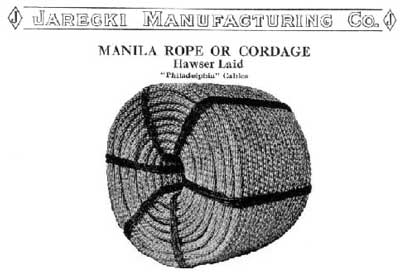 |
||||||
Rope
The manila rope provided considerable elasticity (lash) to the drilling stroke and was used almost exclusively for cable tool drilling until the first decade of the 1900's. A 2 1/4 inch diameter rope cable, 400 to 3500 feet in length is standard (Day, 1922) and weighs nearly two lbs. per foot. Cone and Johns (1870) state that the drilling rope is usually 1 1/4 inches thick which would have been the case in the 1860's. The tools were lighter then too. Diameters of hawser-laid manila drilling cable ranged from 1/2 inch to 2 1/2 inches and had weights of 1/8th lb. to 2 1/8 lbs. per foot.
Here is a bit of trivia. It is said that in 1898 a shortage of manila rope affected the oilfields. This was the year of the Spanish American War. Military action in the Philippines interrupted the manufacture of manila rope which was a valued Philippine export.
The changeover to steel wire cable came in degrees during the first two decades of the 1900's. The Oil Well Supply Company of Oil City, Pennsylvania, in their 1907 and 1913 catalogs commented on the newly invented Smith's wire rope connection and Smith's special crown pulley that would handle both wire and manila rope. At that time 200 feet (or less) of manila line was recommended for use between the downhole tools and the end of the wire rope for the purpose of getting the elastic spring or stretch that drillers were accustomed to. The manila rope used in this fashion was called a "cracker".
By 1913 or before, Oil Well Supply was selling its own wire socket and another one called Babcock. A. Leschen & Sons Rope Company was one of the first to make steel drilling rope and it was listed for sale in the Oil Well Supply Co. catalog. The first Leschen wire drilling lines had their steel strands laid around a manila hemp center which is another example of the changeover period. Leschen & Sons also made the famous Hercules (TM) wire rope which had one red strand to make it stand out. Other companies soon began to use colors, yellow, purple etc. Conversion to the general use of wire line for drilling took place in 1912 in California and the Southwest and in 1915-20's in other oil regions where cable tools were used (Brantly, 1971).
The preferred diameter of wire drilling lines used for shallow wells is 3/4 inch. Portable rigs hastened the use of wire line. However, one still hears of the manila "cracker" when old timers get to talking.
Rope or wire line were used at the oil rig for many other purposes besides drilling, and these lines were usually of less diameter than the drilling cable. Among them were the casing line and the sand reel line.
|
|||||
|
![]()
| © 2004, Samuel T. Pees all rights reserved |
|

